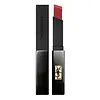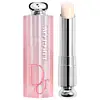What's inside
What's inside
 Key Ingredients
Key Ingredients

 Benefits
Benefits

 Concerns
Concerns

 Ingredients Side-by-side
Ingredients Side-by-side

Dimethicone
EmollientBis-Diglyceryl Polyacyladipate-2
EmollientHydrogenated Polyisobutene
EmollientTridecyl Trimellitate
EmollientPhenyl Trimethicone
Skin ConditioningIsohexadecane
EmollientCI 15985
Cosmetic ColorantHydrogenated Jojoba Oil
AbrasiveDimethicone Crosspolymer
Emulsion StabilisingIsostearyl Isostearate
EmollientParaffin
PerfumingMethylsilanol/Silicate Crosspolymer
Skin ConditioningCera Microcristallina
Emulsion StabilisingKaolin
AbrasiveMica
Cosmetic ColorantVinyl Dimethicone/Methicone Silsesquioxane Crosspolymer
Nylon-12
Polyethylene
AbrasiveCI 15850
Cosmetic ColorantSynthetic Wax
AbrasiveCI 77491
Cosmetic ColorantTriethoxysilylethyl Polydimethylsiloxyethyl Dimethicone
Skin ConditioningIsopropyl Titanium Triisostearate
EmollientCI 77499
Cosmetic ColorantPentaerythrityl Tetra-Di-T-Butyl Hydroxyhydrocinnamate
AntioxidantBenzyl Alcohol
PerfumingLimonene
PerfumingWater
Skin ConditioningPropanediol
SolventBenzyl Benzoate
AntimicrobialAnise Alcohol
PerfumingTocopherol
AntioxidantPelargonium Graveolens Extract
MaskingParfum
MaskingAlumina
AbrasiveDimethicone, Bis-Diglyceryl Polyacyladipate-2, Hydrogenated Polyisobutene, Tridecyl Trimellitate, Phenyl Trimethicone, Isohexadecane, CI 15985, Hydrogenated Jojoba Oil, Dimethicone Crosspolymer, Isostearyl Isostearate, Paraffin, Methylsilanol/Silicate Crosspolymer, Cera Microcristallina, Kaolin, Mica, Vinyl Dimethicone/Methicone Silsesquioxane Crosspolymer, Nylon-12, Polyethylene, CI 15850, Synthetic Wax, CI 77491, Triethoxysilylethyl Polydimethylsiloxyethyl Dimethicone, Isopropyl Titanium Triisostearate, CI 77499, Pentaerythrityl Tetra-Di-T-Butyl Hydroxyhydrocinnamate, Benzyl Alcohol, Limonene, Water, Propanediol, Benzyl Benzoate, Anise Alcohol, Tocopherol, Pelargonium Graveolens Extract, Parfum, Alumina
Polyglyceryl-2 Triisostearate
EmulsifyingHelianthus Annuus Seed Oil
EmollientHydrogenated Castor Oil Dimer Dilinoleate
Skin ConditioningPhytosteryl/Octyldodecyl Lauroyl Glutamate
Skin ConditioningJojoba Esters
EmollientPolyglyceryl-2 Isostearate/Dimer Dilinoleate Copolymer
EmollientEuphorbia Cerifera Wax
Behenyl Behenate
EmollientHelianthus Annuus Seed Wax
Skin ConditioningButyrospermum Parkii Butter
Skin ConditioningOryza Sativa Bran Wax
Skin ConditioningCaprylic/Capric Triglyceride
MaskingParfum
MaskingTrimethylolpropane Triisostearate
EmollientDiisostearyl Malate
EmollientButyrospermum Parkii Butter Unsaponifiables
Skin ConditioningPrunus Avium Seed Oil
EmollientTocopherol
AntioxidantEthyl Vanillin
MaskingAscorbyl Palmitate
AntioxidantUndaria Pinnatifida Extract
Skin ConditioningPropyl Gallate
AntioxidantCI 15850
Cosmetic ColorantCI 15985
Cosmetic ColorantCI 19140
Cosmetic ColorantCI 42090
Cosmetic ColorantCI 45410
Cosmetic ColorantCI 45380
Cosmetic ColorantCI 73360
Cosmetic ColorantCI 77491
Cosmetic ColorantCI 77492
Cosmetic ColorantCI 77499
Cosmetic ColorantCI 77891
Cosmetic ColorantPolyglyceryl-2 Triisostearate, Helianthus Annuus Seed Oil, Hydrogenated Castor Oil Dimer Dilinoleate, Phytosteryl/Octyldodecyl Lauroyl Glutamate, Jojoba Esters, Polyglyceryl-2 Isostearate/Dimer Dilinoleate Copolymer, Euphorbia Cerifera Wax, Behenyl Behenate, Helianthus Annuus Seed Wax, Butyrospermum Parkii Butter, Oryza Sativa Bran Wax, Caprylic/Capric Triglyceride, Parfum, Trimethylolpropane Triisostearate, Diisostearyl Malate, Butyrospermum Parkii Butter Unsaponifiables, Prunus Avium Seed Oil, Tocopherol, Ethyl Vanillin, Ascorbyl Palmitate, Undaria Pinnatifida Extract, Propyl Gallate, CI 15850, CI 15985, CI 19140, CI 42090, CI 45410, CI 45380, CI 73360, CI 77491, CI 77492, CI 77499, CI 77891
 Reviews
Reviews

Ingredients Explained
These ingredients are found in both products.
Ingredients higher up in an ingredient list are typically present in a larger amount.
Ci 15850 is the pigment color red. It is an azo dye and created synthetically.
Azo dyes need to be thoroughly purified before use. This allows them to be more stable and longer-lasting.
This ingredient is common in foundations, lipsticks, and blushes. This color is described as brown/orangey red.
It has many secondary names such as Red 6 and Red 7. According to a manufacturer, Red 6 usually contains aluminum.
Learn more about CI 15850Ci 15985 is a dye made from petroleum. It is synthetically created and approved by the FDA for use in foods and cosmetics.
The color of this dye is orange/yellow.
This ingredient can be found in makeup, sun care, and skincare.
Learn more about CI 15985Ci 77491 is also hydrated iron III oxide. It's sole purpose is to give a red/pink hue to products.
Iron III oxides are classified as inorganic chemicals for coloring.
Synthetically created Ci 77491 is considered safer than those naturally found. This is because the synthetically created version may contain less impurities. Iron oxides are generally non-toxic and non-allergenic.
Learn more about CI 77491Ci 77499 is also hydrated iron III oxide. It is created from mixing red and black iron oxides. This helps give shades of darkness to a product.
Iron III oxides are classified as inorganic chemicals for coloring.
Parfum is a catch-all term for an ingredient or more that is used to give a scent to products.
Also called "fragrance", this ingredient can be a blend of hundreds of chemicals or plant oils. This means every product with "fragrance" or "parfum" in the ingredients list is a different mixture.
For instance, Habanolide is a proprietary trade name for a specific aroma chemical. When used as a fragrance ingredient in cosmetics, most aroma chemicals fall under the broad labeling category of “FRAGRANCE” or “PARFUM” according to EU and US regulations.
The term 'parfum' or 'fragrance' is not regulated in many countries. In many cases, it is up to the brand to define this term.
For instance, many brands choose to label themselves as "fragrance-free" because they are not using synthetic fragrances. However, their products may still contain ingredients such as essential oils that are considered a fragrance by INCI standards.
One example is Calendula flower extract. Calendula is an essential oil that still imparts a scent or 'fragrance'.
Depending on the blend, the ingredients in the mixture can cause allergies and sensitivities on the skin. Some ingredients that are known EU allergens include linalool and citronellol.
Parfum can also be used to mask or cover an unpleasant scent.
The bottom line is: not all fragrances/parfum/ingredients are created equally. If you are worried about fragrances, we recommend taking a closer look at an ingredient. And of course, we always recommend speaking with a professional.
Learn more about ParfumTocopherol (also known as Vitamin E) is a common antioxidant used to help protect the skin from free-radicals and strengthen the skin barrier. It's also fat soluble - this means our skin is great at absorbing it.
Vitamin E also helps keep your natural skin lipids healthy. Your lipid skin barrier naturally consists of lipids, ceramides, and fatty acids. Vitamin E offers extra protection for your skin’s lipid barrier, keeping your skin healthy and nourished.
Another benefit is a bit of UV protection. Vitamin E helps reduce the damage caused by UVB rays. (It should not replace your sunscreen). Combining it with Vitamin C can decrease sunburned cells and hyperpigmentation after UV exposure.
You might have noticed Vitamin E + C often paired together. This is because it is great at stabilizing Vitamin C. Using the two together helps increase the effectiveness of both ingredients.
There are often claims that Vitamin E can reduce/prevent scarring, but these claims haven't been confirmed by scientific research.
Learn more about Tocopherol